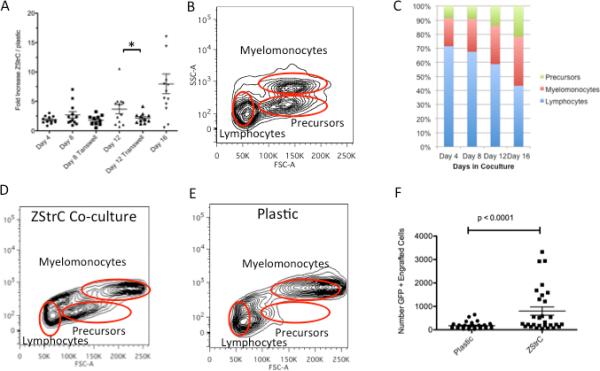Figure 4.

ZStrCs support hematopoietic cells in vitro that can be adoptively transferred. (A) WKM was harvested from h2afv:EGFP transgenic zebrafish and 50,000 cells were placed onto confluent ZStrC or plastic. The same donor was split between both conditions. At each time point, cells were harvested, counted, and analyzed by flow cytometry. The ratio of the number of cells on ZStrC versus plastic was calculated. In some experiments, marrow cells were placed into a transwell at the start of the experiment. Horizontal lines indicates the means, and the asterisk indicates a p-value < 0.05. (B) Forward and side scatter characteristics of zebrafish WKM previously perfused with saline to remove erythrocytes. Gating indicates where various cell populations are located. (C) Zebrafish WKM co-cultured with ZStrCs expands the precursor population. WKM was co-cultured with ZStrCs and the phenotype of the cells was determined at various time points over 16 days by flow cytometry forward and side scatter profiles of non-erythrocytes. Typical forward and side scatter profiles of marrow cells after 16 days of co-culture with ZStrC (D) or on plastic (E). (F) Marrow cells from h2afv:EGFP donor fish were cultured on ZStrCs or plastic for 16 days followed by adoptive transfer into myeloablated recipients. Flow cytometry was performed on recipient WKM 7 days after transplant and engraftment determined by gating on EGFP positive cells.
